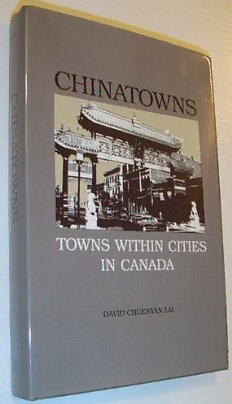
Chinatowns: Towns Within Cities in Canada PDF
Preview Chinatowns: Towns Within Cities in Canada
Chinatowns This book is a definitive history of Chinatowns in Canada. From instant Chinatowns in gold- and coal-mining communities to new Chinatowns which have sprung up in city neighbourhoods and suburbs since World War n, it portrays the changing landscapes and images of Chinatowns from the late nineteenth century to the present. It also includes a detailed case study of Victoria's Chinatown, the earliest such settlement in Canada. David Chuenyan Lai begins by outlining the history of Chinese immigra- tion to Canada and provides an overview of the demographic changes of Can- ada's population of ethnic Chinese, including regional origins, from the pe- riod of free entry (1858-84) to the period of selective entry (1948 and on). He then classifies Chinatowns into four groups—Old, New, Replaced, and Reconstructed Historic Chinatowns—and analyses their origins, locations, viability, and socio-economic and image changes. Focusing on Victoria's Chinatown as a typical example of a Historic Chinatown, Lai employs a stage-development model consisting of four phases (budding, blooming, withering, dying or reviving) which can be used to study Chinatowns across North America. He also describes a public in- volvement model of community planning which is responsible for the suc- cessful rehabilitation project in Victoria—one which has received interna- tional recognition and in which Lai has been extensively involved. The culmination of twenty years of research which has included detailed surveys of over fifty Chinatowns in North America and interviews with nu- merous community leaders and city planners in all major Chinatowns in Can- ada, this book explains why Historic Chinatowns are seen as important by Chinese today and why they may survive despite the competing attractions of New Chinatowns. It also sheds new light on the characteristics of these com- munities and provides useful insights for geographers, historians, sociologists, and anthropologists. DAVID CHUENYAN LAI is an associate professor of geography at the Uni- versity of Victoria. In 1983 he was made a Member of the Order of Canada (CM) in recognition of his work on Victoria's Chinatown. This page intentionally left blank Chinatowns TOWNS WITHIN CITIES IN CANADA David Chuenyan Lai UNIVERSITY OF BRITISH COLUMBIA PRESS VANCOUVER 1988 © The University of British Columbia Press 1988 All rights reserved Canadian Cataloguing in Publication Data Lai, Chuen-yan David, 1937- Chinatowns Bibliography: p. Includes index. ISBN 0-7748-0309-6 1. Chinese - Canada - History. 2. Chinese Canadians - History. 3. Chinatown (Victoria, B.C.) - History. 4. Chinese - British Columbia - Victoria - History. 5. Chinese Canadians - British Columbia - Victoria - History. I. Title. FC106.C5L34 1988 971'.004951 C88--91555-2 F1035.C5L34 1988 This book has been published with the help of grants from the Social Science Federation of Canada, using funds provided by the Social Sciences and Humanities Research Council of Canada; from the B.C. Heritage Trust; and from the Canada Council. Printed in Canada ISBN 0-7748-0309-6 To Man Yuk, Jim Yuan, and Joan Man for their encouragement, understanding, and assistance This page intentionally left blank Contents Figures ix Tables xi Plates xiii Preface xv Acknowledgments xvii 1 Introduction 3 PART ONE: CANADIAN CHINATOWNS 2 Entry without Restriction 15 3 Chinatowns in British Columbia 34 4 From Restriction to Exclusion 52 5 Vicissitudes of Old Chinatowns 68 6 Postwar Arrival of New Immigrants 102 7 Postwar Chinatowns 120 PART TWO: VICTORIA'S CHINATOWN 8 The Budding Period, 1858-1870s 183 9 The Blooming Period, 1880s-1910s 198 10 The Withering Period, 1920s-1970s 231 11 The Reviving Period, 1980s 252 PART THREE: CONCLUSION 12 Retrospect and Prospect 273 viii Contents Appendices 287 1 Chinese Canadians Elected to Public Office, 1957-June 1988 2 Chinese Canadians Appointed to the Order of Canada, 1976-July 1988 3 Chinese Canadians Awarded Honorary Citizenship, City of Victoria, 1971-June 1988 Notes 291 Bibliography 317 Index 337 Figures 1 Chinatown Stage-Development Model: Life Cycle 5 2 Chinatown Stage-Development Model: Morphological Patterns 6 3 Stage-Development of Selected Old Chinatowns 10 4 Source Areas of Chinese Immigrants, 1880s 18 5 Migration Routes of Chinese Immigrants during the Gold Rushes 22 6 Nanaimo and Its Chinatowns, 1880s 38 7 Distribution of Chinese in British Columbia, 1884 42 8 Annual Arrival and Departure of Chinese, 1886-1947 57 9 Geographical Shift of Chinese Population in Canada, 1901, 1941 64 10 Distribution of Chinese by Cities or Towns, 1941 65 11 Cumberland's Chinatown, 1900s 74 12 Nanaimo's Chinatown, 1910s 76 13 New Westminster's Chinatown, 1921 78 14 Vancouver's Chinatown, 1889 82 15 Vancouver's Chinatown, 1927 86 16 Calgary's Chinatown, 1900s 88 17 Lethbridge's Chinatown, 1912 91 18 Edmonton's Chinatown, 1911 93 19 Winnipeg's Chinatown, 1911, 1921 96 20 Toronto's Chinatown, 1910, 1923 98 21 Montreal's Chinatown, 1921 100 22 Geographical Shift of Chinese Population in Canada, 1951, 1981 115 23 Distribution of Major Chinese Communities in Canada, 1981 117 24 Vancouver's Chinatown and Strathcona District, 1950s-70s 127 25 Calgary's Chinatown, 1986 137 26 Edmonton's Replaced Chinatown, 1987 139 27 Lethbridge's Chinatown, 1986 142 28 Winnipeg's Chinatown, 1986 145 29 Toronto's Old Chinatown, 1954, 1984 147 30 Montreal's Chinatown, 1986 150
